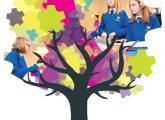Investing in hardware is daunting. Suppose senior management make the wrong choice and everyone ends up stuck with unsuitable, outdated devices? Perhaps this is why for many schools the Cloud is King. Bring Your Own Device (BYOD) has fostered a sense that hardware does not matter; that students will draw down material onto tablets, smartphones or even laptops. In fact any device that is wi-fi enabled will serve the purpose. However, the device does matter – and it is especially important for learners with special needs.
Tablets
More than just desirable consumer technology, iPads also have many useful accessibility options including Large Text (up to 56 point), Zoom and White on Black. Maisie is in year 8 at a school in Harrow and has restricted sight. For a long time she had to work with yards of paper covered with large print text, which proved almost impossible to navigate. Now she uses the iPad camera to take pictures of worksheets and zooms in using the pinch and zoom technique. This works very well with the Invert Colours accessibility option so when she takes a picture of a worksheet, an object in science or a page from a text book, she can invert the colours on the screen so they are white on a black background.
Thanks to her iPad, Maisie uses iBooks to read English literature texts with a large font and Pages to take notes, edit her homework diary and complete worksheets, which can then be emailed or printed out.
LearnPad from Avantis is a fine example of an Android tablet that is a good fit with different types of special needs. Teachers can create profiles so learners don’t go wandering off into cyber worlds but have all their resources corralled. It also has specific accessories developed for students with disabilities, including protective cases and wheelchair mounts.
Keyboards
James Webb, ICT Coordinator at King Richard Secondary School in Portsmouth, has found that using QR codes to take students to texts, videos and websites makes lessons faster paced so there is less tendency for pupils to lose interest. This is especially useful for that group of learners who work slowly, typing in web addresses or scrolling down a page and reading every single word until they find the one section the teacher wants them to look at. But students need to be creators as well as consumers so schools would do well to buy the Bluetooth keyboard from Avantis. It is one thing to send text messages or emails via an on screen keyboard, quite another to write a 1000-word essay.
The standard keyboard, whether on screen or as an external device, will not be suitable for all pupils. Inclusive Technology has a comprehensive range of alternative keyboards including large key and high visibility keyboard for those with sight problems and compact keyboards for those with restricted movement. Mobile phones and tablets with Siri are also a good alternative for many learners so they can get a first draft of text on screen. While text generated via voice will need careful editing to make sure that it makes sense, it does mean learners are not trying to think, handwrite and edit all at once. And it has the added bonus that all the words are correctly spelt.
Pens
Most students still use the good old fashioned pen, especially for examinations, but there have been many advances in technology and these days some pens seem almost as ingenious as the ones created by Q for James Bond. ‘Reading Pens’ as they are often known offer independence to many learners. A good one will scan accurately, read text aloud and link to a dictionary. This might be the Concise Oxford English Dictionary or one with a language option so it can help pupils new to English. Barry Bennett has a good selection including the Quicktionary 2 Premium Scanning Pen, which scans full lines of text, delivers instantaneous word-by-word translation.
The big news this year is that The ExamPen has been approved by The Joint Council for Qualifications (JCQ) for use in exams. Now students who are registered as having reading difficulties such as dyslexia can scan text from their exam paper which will then be read aloud into their headphones. It is a bright orange pen which has ‘ExamPen’ on the screen so invigilators know it is an approved device – students are not allowed to use devices with built in dictionaries as this would give them an unfair advantage. This device costs £190 so it is not cheap – but it will ultimately save schools a lot of money as they will not need to pay for human readers and separate invigilators, because students using the ExamPen can sit alongside other candidates in the main exam hall.
For EAL students Mantralingua has a recorder pen for £45 that lets pupils scan and listen to subject specific words such as mathematical vocabulary or the terminology for poetry in English and then get a translation and definition in a home language. It is very good for EAL learners, especially those coming in with very little English, and can be used with headphones. It comes with 15 languages, including Arabic and Polish, but teachers can record their own languages, too.
MantraLingua also has the LinguaTABlet, which has a 10 inch screen. It comes with a special app so teachers and school administrators can collect details of pupils who have recently arrived in the UK or who are EAL learners. The screen is divided into two panels and both parties can see the information simultaneously, each in their own language.
Parents select their home language and listen to a set of questions. They touch the answers (written and spoken in their home language) and the app automatically fills in the corresponding field in English. Questions cover languages and levels, religion and dietary requirements, medication and allergies and the pupil’s interests.
LinguaTABlet is far cheaper than paying for interpreters to come to a school and means that teachers can make better provision for new arrivals.
3D technology
Visualisers have been described as “a revolution in the classroom”. These ‘document cameras’ project anything from microscope slides to diagrams from a text book and can be used to show techniques in fine detail. When pupils are working on circuit boards in design and technology, they need to see exactly where to apply a soldering iron and the visualiser is an ideal tool for enlarging small objects.
Many children miss out with a standard science or technology demonstration but a visualiser’s ability to blow up images on a big screen is exactly the way to grab interest and focus learners’ attention. It helps them to concentrate better, understand more of what is going on and remember the lesson more clearly. Information can be kept on screen and demonstrations of processes and sequences can be recorded and played back, freeing up the teacher to pay attention to individuals.
Hayley is a pupil with ASD at Davison CofE High School for Girls in Worthing. Helen Davis (Science AST) has noticed that she has problems interpreting pictures as do some of the girls with specific learning difficulties. “Somehow they cannot see a two dimensional image on a page and relate it to something three dimensional,” she explains. “When we study the differences between plant and animal cells we make cardboard models and show them on the visualiser. Somehow working in 3D lets them see the differences so much more clearly and there is less room for misinterpretation.” It seems that, like the best of hardware, it lets students work more effectively and be more independent.
FIND OUT MORE…
Author
Sal McKeown is a freelance special needs journalist and author of Brilliant Ideas for Using ICT in the Inclusive Classroom (Routledge) and a book for parents, How to help your Dyslexic and Dyspraxic Child (Crimson Publishing).
You may also be interested in...











20.7% NUMBER OF BOYS WITH SEN WITHOUT STATEMENTS IN SCHOOLS IN ENGLAND (FOR GIRLS, THE NUMBER IS 13.4%). 2.8% OF BOYS AND 1.0% OF GIRLS HAVE SEN WITH STATEMENTS.